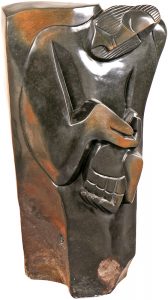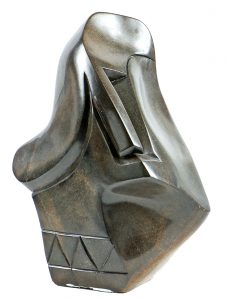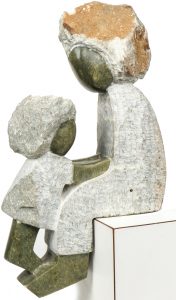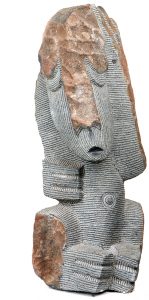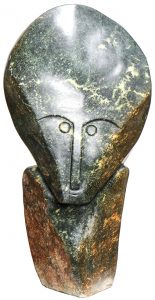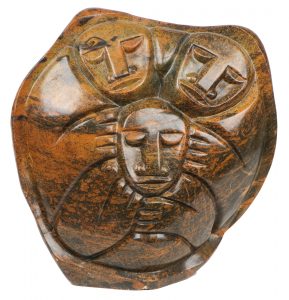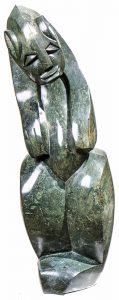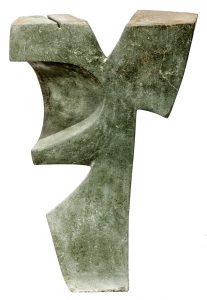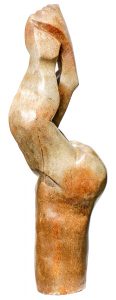SHONA MODERN | The Peggy Knowlton Collection of 20th Century Zimbabwean Art
Collectors and Resellers Take Note: This is a No-Reserve Auction!
Live Auction: Sunday, June 11, 11AM EST
Public Exhibition: June 7-10, 11AM-5PM
Auction/Exhibition Location: 4961 River Rd., Point Pleasant, Pennsylvania, 18950
Make it a Weekend in Beautiful and Historic Bucks County! (Click here)
“Shona sculpture is perhaps the most important new art form to emerge from Africa in the 20th century.”
—Newsweek
“Picasso was an admirer of early Shona sculpture; now evidence is surfacing that he was influenced by it.”
—Town & Country Magazine
Browse the Auction Catalog and Bid Live on these Portals:
Absentee Bid Form | Telephone Bid Form | Terms and Conditions (PDF)
PRESS RELEASE
For immediate release, May 24, 2017
Material Culture will be holding an auction solely dedicated to the Peggy Knowlton collection of modern Shona sculpture. Over 600 lots of stone sculpture by over 60 different artists from Zimbabwe include highlights by masters of the movement such as Nicholas Mukomberanwa, Dominic Benhura and Richard Mteki, and vary in size from diminutive curio to massive show-stopper. Knowlton travelled to Zimbabwe every year for more than 25 years to purchase sculpture directly from the artists, which she would import to place them in exhibitions to benefit nonprofit organizations, or to sell them through her gallery. This auction now bears the fruit of her travels, dedication and discerning eye.
The auction will be held on Sunday, June 11, in Point Pleasant, Pennsylvania, where Knowlton lived for 30 years. The auction exhibition, free to the public, will be open from June 7 to June 10, 11 AM to 5 PM. Both the auction and exhibition will be held at 4961 River Rd. Material Culture encourages art appreciators to take an early summer weekend getaway to Point Pleasant in beautiful and historic Bucks County (just 8 miles from New Hope), and has prepared a list of local museums, restaurants, inns, bed and breakfasts. (Click here)
Furthermore, all of the pieces in the auction are being offered with no reserve, making possible astounding deals for lovers of modern sculpture. Thomas Gamache, himself a collector of Shona sculpture, inherited the collection after Peggy Knowlton’s death in 2015, and he is simply interested in getting the masterworks she collected into homes and other spaces where they can be seen and admired.
Named after the largest tribe in Zimbabwe that engages in sculpting, Shona sculpture has developed an international appreciation among collectors and art scholars who admire its compelling, graceful and distinctive blend of modern and traditional. In the late 1950s, English artist Frank McEwen helped to found what was then the National Gallery of Southern Rhodesia, with the Workshop School, a space that the country’s stone sculptors could come to work. McEwen only wanted to foster the artists’ native talent and vision with no attempt at outside instruction, and the sculptures’ occasional resemblance to modern, cubist or expressionist art of Europe or America is purely coincidental. The sculptors merely mentored each other, working with traditional subjects and the cultural viewpoint that every object has a spirit, and that the spirit in a given piece of stone needs only to be revealed. Most Shona sculptors explain that their process involves contemplation of the piece of stone to uncover the image that already lies within it. When the country won its independence in 1980, the name chosen—Zimbabwe—means “house of stone,” an ode to the mountains that surround it and provide its talented artists with over 200 geologically-catalogued different stone colors.
Synonymous with modern Shona sculpture is the name Mukomberanwa, a family of famed sculptors headed by Nicholas Mukomberanwa (1940-2002), one of the most important figures in the movement. An artist from his boyhood, Nicholas was invited to use the National Gallery’s workshop space in 1962. At first, he continued to work as a police officer while carving sculptures in his spare time, but after several years he devoted himself to his art full-time, and was met with great success. Placement in important exhibitions in Paris, London and New York in the 1970s paved the way for solo shows in the same cities by the 1990s, and his pieces are in the collections of the Museum of Modern Art in New York and the Museum of Man in London, amongst others. The artist’s sculpture “Meditation” lot 9, evokes thoughtfulness through the figure’s large arms wrapping themselves around each other, the face and dominant hands chiseled in a manner reminiscent of art deco or futurist sculpture. Carved in polished serpentine stone, this is a masterpiece of an accessible 14 inches high by 32 inches wide. All of Nicholas Mukomberanwa’s children became sculptors, and the auction also offers a piece by his son Lawrence (b. 1976), entitled “Asking for Help” lot 25. Carved out of deep brown serpentine, this 41.5 inch tall figure supplicates with its head crooked at an angle; as in Nicholas’s “Meditation,” the size and gestural power of the hands are central in the image.
Richard Mteki (b. 1947), another well-known first generation Shona sculptor, has many biographical parallels to the elder Mukomberanwa. Mteki’s skill at carving attracted the attention of Richard McEwen, and after working under the encouragement of the National Gallery for several years, Mteki began to pursue sculpture full-time. In the 1980s, Mteki was commissioned by the new government of Zimbabwe to create several sculptures, including a massive one-ton sculpture of the national bird for the National Sports Stadium in Harare. His international exhibitions include France, Sweden, and multiple shows in England, Australia, and the United States. Like Mukomberanwa, Mteki draws on the folklore of the Shona tribe, and his sculptures often exude spiritual calm. His abstracted faces are often pensive or gently watchful, as with his spectacular “Peacekeeper,” lot 15 a serpentine springstone sculpture particularly redolent of cubism.
The masters of the second generation of modern Shona sculpture are also well-represented, led by Dominic Benhura (b. 1968), shown in several pieces at auction. Benhura’s excellence as a student as a young boy meant he was sent to attend a special primary school while living with his uncle—but it was also where he became the pupil of the established sculptor Tapfuma Gutsa, his cousin. Though he excelled in both his studies and in art, it was the latter that he took up as his lifelong vocation. With work in group and solo exhibitions in England, Sweden, Spain, the United States, South Africa and his native Zimbabwe, Benhura is internationally regarded as one of the most important second-generation Shona sculptors. Benhura’s sculptures at auction, including his delightful “Playtime” lot 197 and “Playful Boys” lot 68 are very representative of his work, which frequently depicts familial groups or friends romping together. The acrobatics of their relationships are also seen in solitary figures, such as his “Walking the Line” lot 61. Behnura uses the texture and irregularities of the stone by leaving the figure’s hair and clothing rough, while the skin—faces, hands, legs—are polished to a smooth perfection.
Another of the most famous second-generation Zimbabwean sculptors appearing in the auction is Edronce Rukodzi (b. 1952), whose work has appeared in many galleries and museums in Europe and the Untied States . The nephew of one of the undisputed first-generation masters, Henry Munyaradzi, Rukodzi studied with Munyaradzi when he joined the Tengenenge Sculpture Community. This mentorship had an undoubted impact on the young man’s work, but Rukodzi developed a distinctive style that is entirely his own. There are three possible textures in a Rukodzi sculpture—unfinished stone, smooth polish, or deeply chiseled grooves—and he juxtaposes all three to dramatic effect. His signature grooves are frequently in parallel lines along the contours of the sculpture, giving the image rhythm and vibration, as seen in his masterful “Contemplation” lot 210, a seated figure with one arm resting on the side of its head. The contrast of the highly-patterned parts of its melancholy face and body with the large swaths of stone left completely unfinished is captivating, and draws attention to the Shona process of creating the sculpture that already exists within the rock.
Also mentored by Henry Munyaradzi was the artist Factor Ziira (b. 1954), one of the most well-represented sculptors in the sale with over 30 lots. Ziira was Munyaradzi’s son-in-law, and served as Munyaradzi’s assistant in the late 1980s, subsequently taking up sculpting himself. Ziira’s figures and spirits, largely polished with an occasional usage of rough surface, frequently bear the same little smile—a peaceful, agreeable presence showing up in sculpture after sculpture. His piece “The Messenger” lot 250 carries a greater sense of omniscience than of peace, with the dominating size and shape of the figure’s forehead and the exquisite marbleization of the fruitwood serpentine stone evoking a storm of thoughts. Other highlights by Ziira include “The Chief and His Council” lot 23, “Protector” lot 242 and “Fortune Teller” lot 233. Factor has, in turn, taught his son Sailot the craft, and Sailot Ziira (b. 1981) is considered to be one of the potential great masters of the third generation of modern Shona sculptors. Sailot’s sculpture “The Peace Keeper” lot 12 could actually be an interesting companion piece to “The Messenger;” the figure’s similarly-shaped broad forehead features a miraculously brain-shaped irregularity in the otherwise dark serpentine stone. Both Factor and Sailot Ziira have all been part of multiple shows in galleries and museums in Europe, the United States, and at home.
The list of internationally-recognized artists continues with Nevinson Solomon (b. 1963), a significant second-generation artist who ended up being mentored by Richard Mteki. Solomon came from a farming family, and worked himself as a farmer and office clerk. He began helping his uncle, Richard Mahoyo, with his stone carvings, but when his uncle died, he was left with a passion for carving but very little training. Mteki invited Solomon to visit him and Solomon ended up working with him for a year before setting up his own workshop. Though Solomon’s works are very much his own, Mteki’s influence can be seen, for example, in the composition of his “Family Strength,” lot 402, in which two parents embrace their child, crowded tightly within the shape of the stone. Depictions of family are common in Shona sculpture, but this sculpture resembles Mteki’s variation more strongly than any others; at the same time, Solomon has allowed a small border of the stone’s shape to stand out around the familial group, drawing more attention to the canvas of the stone and also endowing the figures with a kind of collective halo. Mteki was also responsible for fostering the talents of another second-generation master, Vince Rangisse (b. 1959). Unlike the majority of artists in this sale, Rangisse is not ancestrally part of Zimbabwe’s Shona people, but from neighboring Mozambique. From a poor family, Rangisse went to Zimbabwe at the age of 21 to work as a builder at a construction company. Eventually, he had a job building a house for Richard Mteki, who was so impressed with the young man’s craftsmanship that he encouraged him to use it to artistic ends, and Rangisse now runs a large studio in Zimbabwe. His most frequent subject matter is ancestor spirits, often carved on both sides to show the spirit caring for the living, and is sometimes highly abstract, as seen in “My Spirit and Me” lot 555 and “Watchful Spirit” lot 80, only two of approximately 30 lots that Rangisse has in the sale.
The auction also highlights the work of Robert Kwechete (b. 1959), the most famous animal sculptor in the modern Shona movement. Kwechete’s giraffes, kudus, elephants and hippos have an international following, and are in the collections of several European royal families. As a boy growing up in the Inyanga mountains, Kwechete felt a mystical kinship with the African wildlife he saw in its natural habitat, which is gorgeously expressed in his sculpture. Marvels of negative space, his pieces create several animals carved out of one stone, swirling around each other. His “Giraffe Trio” lot 3, perhaps his favorite among animal subjects, shows a family of giraffes twining around each other and interlocking necks, seemingly light for the dark serpentine stone from which they were carved.
Two artists who prefer carving with colorful stones are Singi Chihota (b. 1975) and Crispen Karanda (b. 1955). Singi Chihota began carving at the age of 12, mentored first by his father, sculptor Luke Chihota, later joining the Tengenenge Art Colony, and finally the Rukodzi studio, led by Edronce Rukodzi, his cousin. Rukodzi’s rhythmic grooves can be seen in Chihota’s work, though the younger artist’s texture tends to be more delicate, and are frequently complex patterns of wave shapes or interlocking patterns rather than simply following the different contours of the form. He carves in a range of stones, but prefers colorful serpentine and particularly green opalstone to create nearly luminescent images. Shona spirituality frequently figures in his work, as with his lovely opalstone piece “Dream Guide” lot 10, its downturned eyes at a peaceful tilt. Crispen “Mac” Karanda, born to a poor family, has applied himself to sculpture as he has all other things in life; though he was only able to complete his education due to the patronage of a man he chanced to meet from the UK who saw potential in him, Karanda is the proud holder of a Masters Degree in Business Studies. Unlike many of the other artists in the auction, he had no stone carving mentor, and merely applied himself to the art once he picked up in the late 1990s. Karanda carves solely with red serpentine, or jasper, that is found in his rural hometown. The relationship between parent and child is a common theme, but it is treated in a number of unique ways. “Child Nature” (lot 000) and “My Special One” lot 98 both nestle two faces, a large and a smaller one, within the shape of the stone. The form of “Child Nature” could be representative of a shawl wrapped around the embracing pair, while “My Special One” remains distinctly abstract.
In addition to Chihota and Sailot Ziira, several third-generation masters take their place in the sale. Edmore Sango (b. 1977) is arguably a third-generation artist despite being the brother of second-generation luminary Brighton Sango, who was born in 1958—but the nearly twenty-year age difference between the two creates this gap. At seven years old, Edmore asked his brother to teach him to carve, but Brighton wouldn’t start teaching him the basics until he was eleven. Brighton was delighted with his youngest brother’s enthusiasm, and continued to mentor him until his death in 1995. The following year, Edmore moved into his brother’s house and workshop and became a full-time sculptor. Brighton’s sculpture was more geometrical and abstract than many of the other modern Shona artists, and Edmore’s has followed suit. Some are still recognizably figural, while others appear to be spatial explorations of the title’s concept. Others, like his “Abstract 11” lot 11, carved in a gorgeous pale green Nyanga Mountain serpentine, are free to take off from the earth without any narrative to bind them. Well-known sculpting brothers Forrich Takavada and Isaac Takavada (b. 1972) contribute many lots to the sale, Isaac with 16 and Forrich with nearly 35, the latter a corollary to what an intensely prolific artist Forrich is in life. A majority of his abstracted figures radiate relaxation or satisfaction, with titles like “Happiness” lot 222, “Hugging Myself” lot 408 and two entitled “Contentment” lot 451.
Raymond Chirambadare (c. 1972-2006) was on the path to becoming one of the great masters of Shona sculpture, but AIDS tragically cut his life short at the age of 34. He shared a workshop with three of his brothers and his sons, where he also mentored younger artists such as Nicholas Childhawu and Peter Gwisa. Chirambadare’s spectacular piece at auction, “The Diver” lot 4, shows the upside-down torso and legs of a figure who appears to be diving into whatever surface the sculpture rests upon. Rendered masterfully in a serpentine stone of mottled tan, red, and brown, the sculpture takes on the tone of rosy flesh when viewed at a distance. This playful theme, which is found occasionally in Shona sculpture, creates a sculpture that is exemplary of the unplanned fusion of modernist line and traditional subject.


